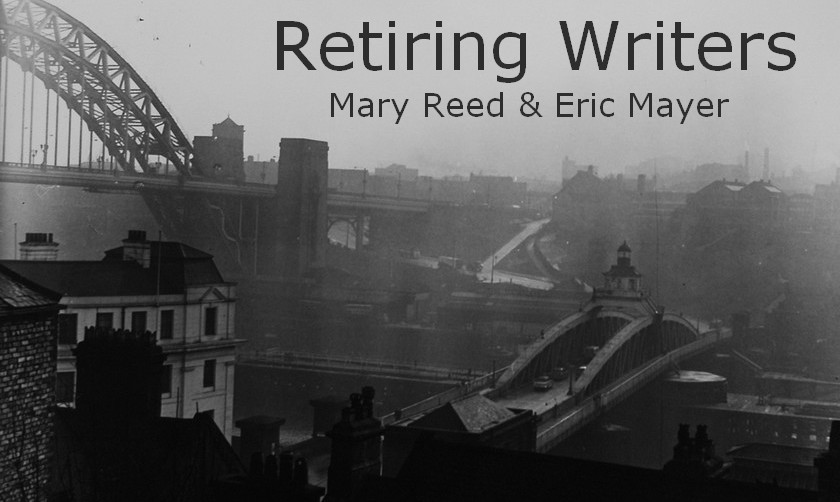As with all readers, bookcases have been a constant presence in my living spaces.
The first graced a Victorian terraced house, the attic of which became the bedroom I shared with my sister. Its furnishings included a tall, white-painted bookcase which for unfathomable reasons had at some point been sawn in half vertically and was therefore held together by its shelves. Its idiosyncratic construction went well with the attic's working gas light and the previous tenants' tartan wallpaper clashing in eye-watering fashion with a contemporary sofa covered in fabric patterned with angular yellow and orange shapes that would have gladdened the hearts of cubist painters.
Since the bookcase had no back, we could see its lower part blocked a small door in the wall. Naturally we opened it and found it disclosed a clear view of a concealed narrow space running down the street between our neighbours' attic walls and their eaves overhangs. What purpose it could have served remains a mystery to this day. Assuming neighbouring attics had similar little doors, the arrangement would certainly have been useful for leaving the premises unnoticed and in haste when an urgent need for departure presented itself, such as when the rent man came to call or a polite policeman appeared at the front door.
Such secret places and especially hidden rooms have long fascinated me, so I particularly enjoyed reading Allan Fea's Secret Chambers and Hiding Places last month. https://www.gutenberg.org/ebooks/13918 Published in the early 1900s, it describes a number of concealed hiding places utilised by, for example, priests during religious persecutions and fleeing royal personages and their supporters at times of civil unrest. Most of these concealed chambers, often situated behind fireplaces or wainscoting, were in great country houses and displayed impressive ingenuity in their construction. Lots of ideas here for authors who need a secret room for plot purposes!
As Mr Fea's book relates, the entrances to these secret rooms were to be found in a variety of locations, including under window-seats, behind cupboards (one mentioned swung backwards, shelves included, to reveal the hidden space), or concealed behind paintings or sliding panels. My favourite in the latter category formed the back of a -- you have guessed it! -- bookcase seemingly fixed to the wall. Disguised trap doors are also touched upon. Fine workmanship was displayed by a particularly ingenious mechanism, whereby a hidden space could only be opened by pulling up the head of what appeared to be a nail in the floor, thereby releasing a spring opening the trapdoor. I was particularly struck by a correspondent quoted in the book who revealed touching an unspecified part of the family shield displayed in the state-room of his castle caused said decoration to revolve and reveal a hidden staircase. Its oddly numbered steps were solid but, he reveals, treading on any of the others started concealed machinery that collapsed the staircase, precipitating unwary pursuers into a vault seventy feet or so below. A devilish device worthy of the lairs in which Fu Manchu lurked!
Constructing such concealed spaces was necessarily done in great secrecy but time marches on and nowadays there are Youtube tutorials on how to build them. However, the nearest I've been to a hidden space, or knowingly at least, was when I lived in a flat in Florida. It was a couple of weeks before I realised the shelved wall in a cupboard next to the front door could be moved. The space thus revealed held part of the air conditioning equipment and was just big enough to admit someone to work on it without ending up with bruised elbows. On the other hand, a couple I know once lived in an old house converted into flats. On my first visit, they pointed out the sash window of a room they noticed had no visible door inside the house. Even more peculiar, the top half of the window was slightly down. It may be they were pulling my leg, but recollecting that white bookcase makes me wonder...
Hiding places for people or objects swarm in fiction. Stolen gems, wills, and compromising correspondence are commonly hidden in them. Sometimes concealment is temporary but on occasion the person involved remains entombed by accident or design until death releases them from durance vile. Apart from the fictional examples mentioned, my meanderings through literary gardens have led me to drawers hidden *within* hidden drawers and objects concealed in locations as diverse as a sundial, wells, a watch or pudding, between paving stones, in the handle of a tennis racquet, and down a rabbit hole.
A reader may well find concealed rooms in works other than mysteries. The Sanctuary by E. F. Benson I consider among the more disturbing of hidden room tales. Though I knew the plot, it still gave me a touch of creeping heebie-jeebies when I reread it recently. Edward Bulwer-Litton offered his readers a trapdoor leading to a hidden room in a house with an evil reputation in The Haunted and the Haunters. Were a vote taken it's possible the most widely read locked room story would be Oscar Wilde's The Canterville Ghost, where the hidden room is used to punish.
While writing An Empire For Ravens, we donned hard hats and big boots to construct an underground cistern, one column of which we fitted with a secret door turning on a pivot. This arrangement permitted our protagonist John and other characters access to a catacomb in Rome. Sounds somewhat unlikely, but oh, brabjous day! In passing Mr Fea mentions sections of massive stone columns in some ecclesiastical buildings and castles were capable of being rotated to reveal hidden spaces, thus showing our architectural invention was not as unlikely as it seems.

No comments:
Post a Comment